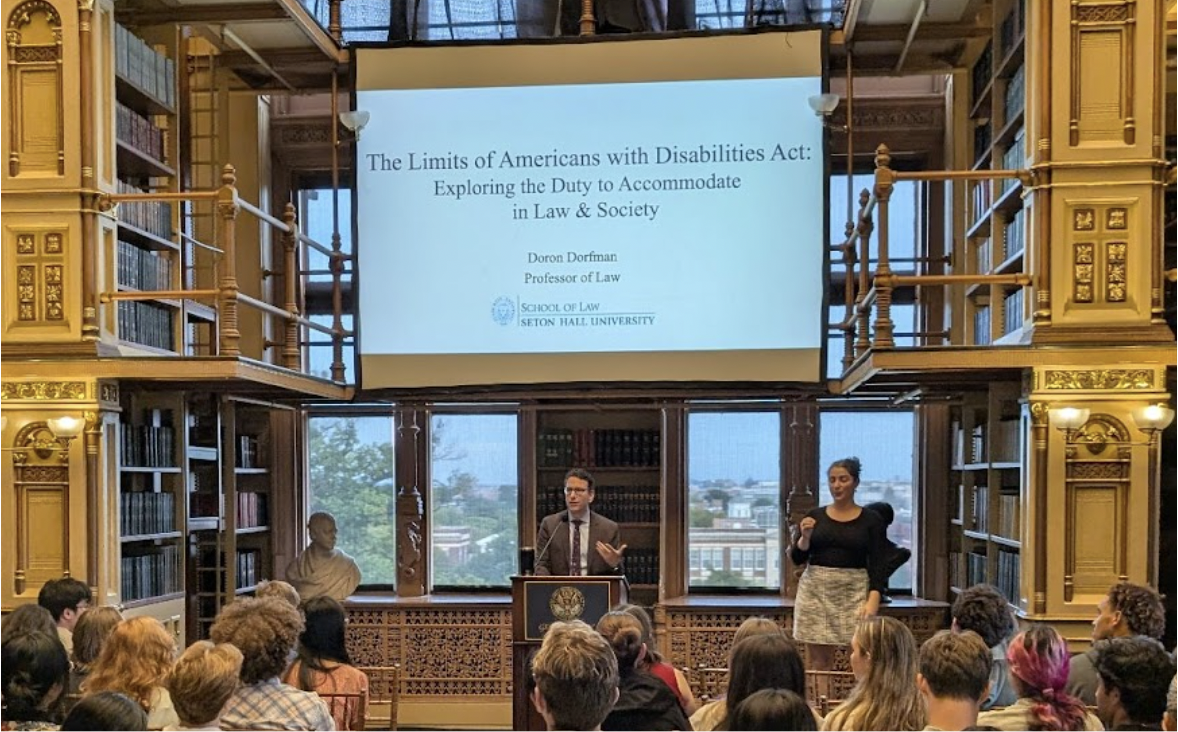An epidemiology professor at the University of North Carolina at Chapel Hill (UNC) discussed a population-based study she leads that aims to understand the social and molecular determinants of breast cancer outcomes at a Sept. 11 Georgetown University event.
Melissa Troester, a professor of epidemiology at the UNC Gillings School of Global Public Health who leads the Carolina Breast Cancer Study (CBCS) at the Lineberger Comprehensive Cancer Center, hosted the first session of the 2025-2026 Oncology Grand Rounds lecture series. The seminar focused on CBCS research regarding the social and biological outcomes of breast cancer.
Laura Rozek, the co-leader of the Cancer Prevention and Control Program at Georgetown’s Lombardi Comprehensive Cancer Center, introduced Troester and her work, explaining its connections to Lombardi.
“Her research really touches on a lot of the things we like to do here at Lombardi,” Rozek said at the event. “She focuses on biomarker development and validation and genomic methods, that are combined with epidemiologic methods, and breast cancer.”
Breast cancer is the most common cancer for women in the United States, with around 270,000 women diagnosed and 42,000 dying from the disease every year, according to the Center for Disease Control (CDC).
Troester began the seminar by explaining how her study applies multimodal learning to breast cancer research. She said this process involves analyzing various factors, including biological, social and geographical ones, to understand why individuals with the disease have different outcomes.
“It’s usually thinking about combining multiple elements that have information about an underlying phenomenon,” Troester said. “So in the case of breast cancer, this could be combining genomics with tissue level, information, organs, organismal level data, things about behavior, biobehavioral information and then ultimately, community information and geography. So the goal is to combine all these things in a person-centered way so we can better understand why people have different outcomes.”
This multimodal approach to research is highly relevant to the CBCS, which has been ongoing for over 30 years and began with the goal of recruiting groups disproportionately underrepresented in breast cancer studies, such as Black women and younger women.
With this goal in mind, Troester said there is a disparity in breast cancer recurrence rates.
“At 7 years, almost 11% of Black women have had a recurrence whereas white women have only had 6%,” Troester said.
Troester said CBCS’s research also found differences in treatment, with Black women receiving more chemotherapy instead of endocrine therapy, which is the standard of care for hormone receptor-positive breast cancer.
“So what we found in our data is that Black women with more aggressive tumors were getting more chemotherapy, but unfortunately — and this is inconsistent with the guidelines — they were getting less endocrine therapy,” Troester said.
Endocrine therapy, also known as hormone therapy, is used after surgery to reduce the risk of the cancer returning in the future. It works by blocking hormones like estrogen and progesterone that can attach to receptors on breast cancer cells and help them grow.
Genomic tests can help predict the likelihood of cancer recurrence by analyzing a tumor’s specific genes.
Troester’s research found that genomic tests based on proliferation, or cancer growth rate, were more accurate than Oncotype DX (ODX), a type of test based on estrogen response, in predicting recurrence. She said they were able to improve the ability of ODX by adjusting it to account for the fact that not all women received the same therapy.
“There’s nothing wrong with ODX,” Troester said. “It is tracking relevant biology. It’s just it’s tracking biology that assumes that the standard of care will be met and that proliferation will be controlled by the endocrine therapy. And that is not what’s happening in the real world.”
Troester also said that individuals in lower-income communities tend to face barriers in receiving genomic testing.
“We also have observed in our data that even when we get innovations that are meant to address disparities, that we don’t always receive them,” Troester said. “About 40% of women who are eligible for ER-positive, HER2-negative testing for genomic assays get it, and the people who don’t get it tend to have lower education and income, and they tend to be in those communities that have low assets or low affordability.”
Alexa Garber (CAS ’28), a Georgetown pre-med student, said she believes this type of research is highly important to ensure everyone receives adequate care.
“I think it is critical that researchers continue to focus on these social determinants and what kind of effect they have on our population’s health,” Garber told The Hoya. “It’s just so important to ensure that all people are included in healthcare and everyone is able to receive the treatments they need to live fulfilling lives.”
Troester emphasized the importance of taking social context and community-level data into consideration to improve population health on a wider scale, stating it is only with such information that steps can be taken to improve population health on a wide scale.
“What I think we really want to build, and which data science is making possible with some significant limitations that we’re still going to have to figure out, is the idea that we could take all of the social context and the learning healthcare systems and our community level data, and build the tools that allow us to implement projects that lead to improved population health,” Troester said.




